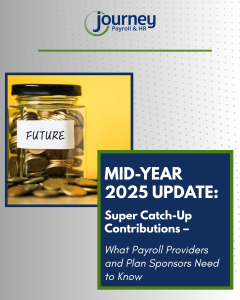As we move through 2025, the Super Catch-Up Contribution provision from the SECURE 2.0 Act is now in effect, introducing a significant boost to retirement savings for employees aged 60 to 63. This provision allows for contributions of up to 150% of the standard catch-up limit, equating to $11,250 in 2025. While this is a huge advantage for late-career savers, it continues to introduce administrative complexities for payroll providers, plan sponsors, and HR teams.

Status Update on Mandatory Participation
At this point in the year, there remains no definitive IRS ruling on whether the super catch-up provision is strictly mandatory or optional for plans that already allow regular catch-up contributions. Here’s the current landscape:
- Automatic Inclusion (By Reference): If your plan references IRC Section 414(v) for catch-up contributions, the provision likely applies automatically. Employers who did not amend their plan documents by December 31, 2024, are presumed to be participating.
- Optional Adoption (Pending Final Guidance): While some practitioners argue for optional adoption by December 31, 2026, the conservative best practice has been to prepare for implementation in 2025.
Bottom line: If you did not opt out by the end of 2024, your plan likely defaults to including super catch-up contributions for eligible employees in 2025.
Plan Document Amendment Timeline (Current Status)
- December 31, 2024: Opt-out deadline — has passed.
- December 31, 2026: Final SECURE 2.0 deadline for formally adopting or finalizing amendments to your retirement plan documents.
If you haven’t revisited your plan documents yet, mid-year 2025 is an excellent time to consult with your retirement plan advisor to confirm your plan’s current status and ensure proper documentation is on track for 2026.
Payroll Provider Coordination — Mid-Year Checklist
At this stage, payroll systems should already:
- Track employee ages accurately to apply appropriate contribution limits.
- Apply the correct super catch-up limits for employees aged 60–63.
- Integrate with your retirement plan provider to support contribution flows and reporting.
If your system isn’t yet handling this properly, immediate action is critical to ensure compliance for the remainder of 2025.
Key Questions to Ask Your Payroll Provider:
- Are super catch-up contributions correctly applied for employees turning 60–63 this tax year?
- Are age milestones dynamically updated in the system?
- Has any mid-year testing been done to ensure no processing errors?
Employee Communication – Don’t Skip This Step
With the program now active, employers should ensure eligible employees:
- Understand their increased contribution limits.
- Know whether their plan is applying traditional or Roth catch-up options.
- Receive clear communication on eligibility and contribution processes, especially if they become eligible mid-year (e.g., turning 60 during 2025).
Journey Payroll & HR Keeps You Covered
At Journey Payroll & HR, we proactively updated our systems to fully support super catch-up contributions starting January 2025.
- If you opted out by December 31, 2024, no action is needed, our system reflects your election.
- If you didn’t opt out, we’ve already enabled these contributions for your eligible employees.
Not sure where your plan stands or need help updating your documentation? Reach out to us, our team is ready to guide you every step of the way.